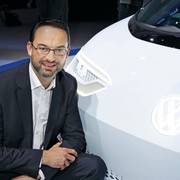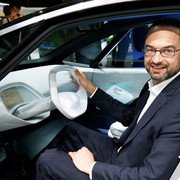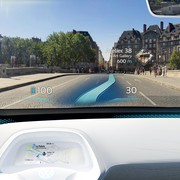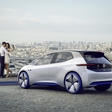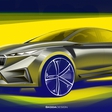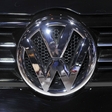
VW is entering a new era, with the announcement of a whole new strategy built around a pivotal electric axis, and also an ambitious plan for mobility services.
Christian Senger is the man leading the development of the new G4 platform, which will be the technical base of all the future EV cars from the VW Group. The ex-BMW and ex-Continental engineer tells us that VW plans to be the first manufacturer "to reach 1 million EV vehicles produced in 1 year" and that "by 2020, cars may well be considered tablets on wheels."
Up until now, VW has had EV cars that were visually identical to the internal combustion engine models. That will change in the mid-term future. What led to that change of philosophy?
We talked to the current e-Golf customers, to find out what they wanted for the future, and they tell us simple things: give us more range, lower the price, improve the charging process. And the MEB (Modular Electric Platform) platform is the answer. From 400 to up 600 km of EC range would probably be enough, and we know that it is not possible to take an existing body of an existing car and fit the batteries that would generate such a driving range. Yes, the newly-presented Golf, for 2020, will be able to cover 400 km with the current body, but then we will have reached the limit. And that will not be the technical answer we need to allow e-mobility to become almost equivalent to combustion mobility, as far as driving range between charging/refilling processes is concerned.
Is the G4 platform a direct consequence of VW´s "Dieselgate" or, on the contrary, would this have been an inevitable future for VW?
Looking into market trends we see, for instance, in China, and also CO2 compliance regulations point in that direction. VW needs to have 20 to 25% of zero emission vehicles in the mid-term future, so I don´t see how we could avoid this path. Maybe the level of consciousness and urgency was accelerated after the "events" happened, but it would come. No chance to go around it. I, for instance, joined the company in January, and here you have, some 9 months later, the MEB platform born, as fast as a human baby.
Is MEB able to use some components from existing non-EV VW Group platforms, or is it a new technical base, built from scratch?
It is new, from scratch, but there are many components which can still be used from existing vehicles. The suspension is dedicated, as we need to create the space for the batteries by having short axle systems, and we make space for the electric powertrain in the rear (where MQB would not be a solution) and for power electronics (reducing complexity and costs). But things like door lock systems and such minor components we may use from the existing cars.
Will you turn to ultralight raw materials (like BMW, with the carbon fiber strategy, for instance) as a means to up EV range, or is it no longer vital with new high-density batteries, 48V electrical systems and other technological breakthroughs?
Our main goal is to democratize e-mobility and make range an affordable commodity. So at VW there is no space for high-end materials. We will go in a lightweight concept, using mainly high-rigidity steel and aluminium.
General Motors surprised the world with a $170/kWh cost for the upcoming Ampera-e batteries, which allegedly will allow them to sell their compact EV car at around 30,000 euros (before incentives), also hinting that high production volume (as the car will be on sale globally) is the key for them. Is your strategy similar?
We have two main approaches to lower the cost. First, it is a matter of simplification: current vehicles - like the e-Golf - have limited space, forcing us create ultra complex batteries. The MED has a "chocolate bar" underneath the interior, which is highly simple to integrate in a very low position. Then, you are right, it is fundamental to reach high volumes, and that is why we have set a target to be the first to build more than 1 million EV vehicles in just 1 year. In order to be able to do that, we will need more lithium-ion (Li-Ion) production capacity than the global production of lithium-ion was last year. If all the companies currently producing Li-ion in the world were supplying us, still it would not be enough to reach that goal. This means we will be generating value streams and markets, and this is exactly what we will do.
Is Li-Ion the foreseeable future of battery chemistry, or is there something coming up for a later stage?
Clearly Li-Ion. There is still a lot of potential of energy density increase (currently we are at an average 6% annual density increase) even if we are closely monitoring new chemistries.
Will you offer different range levels according to customer needs?
Indeed we will. 400 km will be the standard and then we will add 100 km packages as options. Just like you increase today the horsepower or the number of cylinders.
What are the main highlights that have made it possible to have a Golf sized car offering a Passat sized interior roominess?
The "chocolate bar" I mention is the key element. It allows us to have an almost flat floor and thus more interior space while lowering the centre of gravity. The heaviest part of the car is exactly in the lowest point of the car and we end up with a weight distribution which is almost 50%-50% (and that is why we decide to have rear wheel drive because on a front wheel drive car we need a different weight distribution, closer to 60%-40% as the heavier front is vital to put the torque on the ground).
Your CEO has recently told media that the G4 platform will generate a subcompact SUV, a Coupé and a Phaeton successor, besides the ID. Are there body shapes more and less suitable for the G4 platform, or is it as flexible as it seems, judging by this variety of promised vehicles?
It is very flexible, because it is so simple, so different body types are no problem. Hardly any package constraints, really. And also allowing us to expand technologies which have been limited in the ICE cars: one example is the head-up displays, since we don´t have the engine in the front, there is a lot more space to use with really big head-up displays, the largest in the industry so far. In a nutshell, premium features at an interesting price point. On the other hand, the evolutionary huge step we are taking will allow the young generation in 2020 to consider the car a true tablet on wheels. It will have an operating system (more or less Linux based), there will be an app store to download upgrades and updates, and this will help to slow down the aging process of the car. This is the base of VW providing a mobility ecosystem, as announced by our Group CEO, Mathias Muller.
Today, MQB and MLB are used by all the mainstream brands in the VW Group. On the other hand, your Group CEO informed the shareholders in June that there would be over 30 EV vehicles in the company by 2025 (two to three million produced annually, up to almost 1/3 of the global output from VW Group). That can only mean MEB will be used by the other brands in the VW Group. Maybe with 12V electronics, but probably also with 48V...
Yes, it is part of our volume strategy, for sure. The MEB platform with a 2,75 m wheelbase is enough to cover our model range, from the Polo to the Passat. Then, on more premium brands, and when in need of more powerful motors, 48V will play an important role.
If you solve the range anxiety and the high costs issues affecting e-mobility today, you will be left with the user-unfriendly charging process. Will you have widely available wireless charging for your customers, by the time the ID production version starts rolling out of the assembly lines?
That is the plan. Up to 11 kWh charging through wireless charging by 2020, when the ID production version hits the market (meaning 5 to 6 hours to fully charge an e-Golf).
The Beetle and the Bus were the founding pillars of VW. Will the ID and the e-Buddy play identical roles in the re-invention of the brand?
In our own internal terms, we say we introduce the third reinvention of VW. The Beetle was the car for the post-WWI crisis, the Golf was the answer to the oil crisis in the 70s, and now the ID and the Buddy are the company´s solution for the future. It will be interesting to see, in 2025, how many Golf cars we will sell, and how many IDs we will sell, but for sure the impact on our business will be at least as important as the introduction of the Golf back then.
Will fully autonomous driving be available in any or all the new EV model range, and do you plan to include it as level options, as if the customer is specifying air conditioning or leather upholstery?
The MEB is prepared for the integration of all levels of automated driving. We will start with highly-assisted driving features, and will increase gradually to fully autonomous operation.
